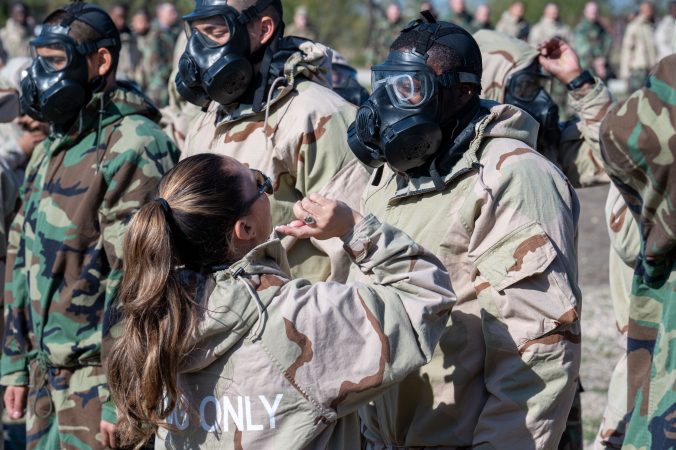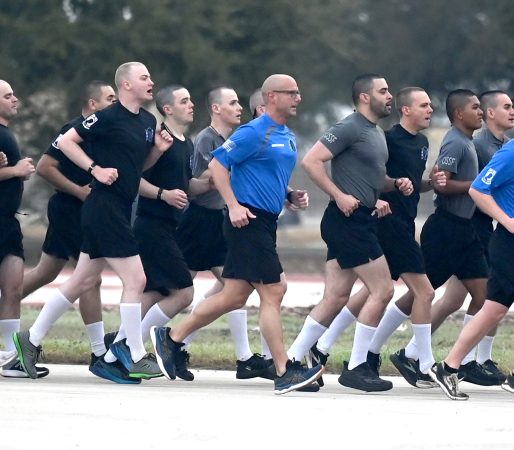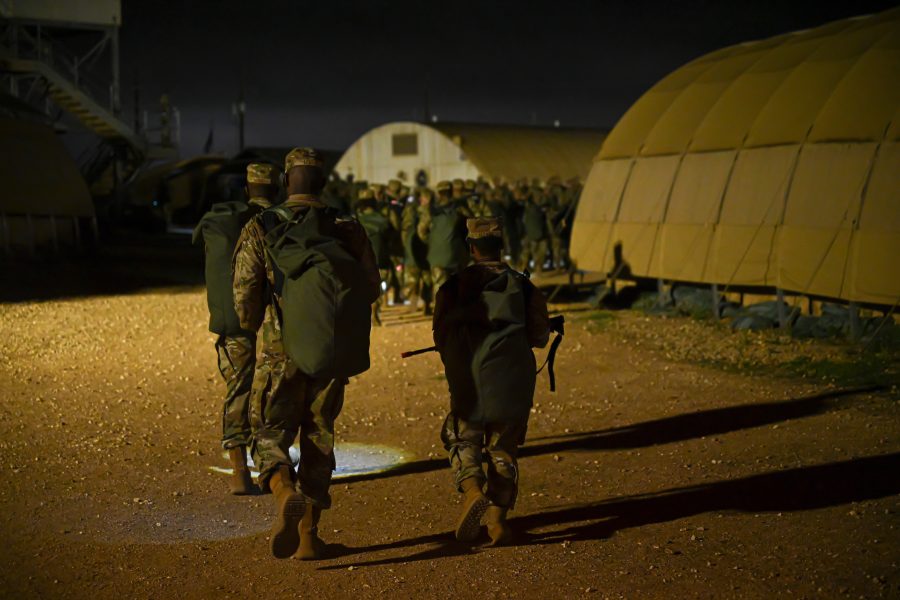Air Force training officials are planning changes to Basic Military Training that could take trainees out of the classroom more often to better prepare them for the rigors of modern warfare.
Beginning in the fall, 2nd Air Force Commander Maj. Gen. Wolfe Davidson plans to introduce a new curriculum for boot camp that will focus on training Airmen and Space Force Guardians in much smaller groups, while replacing some classroom instruction with a more hands-on learning approach.
Training officials are also looking at increasing daily physical fitness training and adding exercises designed to mimic combat tasks.
Davidson, who oversees BMT and follow-on technical training, is tailoring the effort to match both Secretary of Defense Pete Hegseth’s directive to restore warrior ethos in the ranks, and the service’s new initiatives to prepare for competition with the likes of China and Russia.
“How do we make sure that Airmen show up with the warrior ethos and understand their role in a high-end fight, not just in a fight, but in a high-end fight. … For us, that starts at Basic Military Training to kind of create the mindset that we would then build throughout technical training, Davidson told Air & Space Forces Magazine.

Davidson said he began to review BMT in August to figure out if it is preparing trainees for the current threat environment and how it fits into new Air Force operational concepts like Agile Combat Employment and Combat Wings.
“Then the new SecDef’s guidance that came out on [warrior ethos] … just really put the fuel behind this as it continues to move ahead,” Davidson said.
Air Force officials have actually been talking about promoting a “warrior” mindset dating back to the mid-2000s, saying then it was to better prepare Airmen to operate in combat zones in Iraq and Afghanistan.
Over the years, the concept of warrior ethos has been often misunderstood, said Davidson, who comes from a Combat Controller background.
“So people would think you were a warrior because of what you did–so, you know, do you carry a weapon and are you close to the enemy?” Davidson said. “But in actuality, that’s not what we’re trying to create with a warrior ethos. What we’re really trying to create is the understanding of why you do the things that you do. … It doesn’t matter what you do. It matters why you do it, and the reason that you do it is to defeat an adversary.
“So it’s about creating that mindset and changing this concept of, ‘well, I’m not the person pulling the trigger, so I’m not really a warrior,’ to ‘what is it that I do that’s going to contribute to our success’ as that basic guiding principle.”
The Air Force has already rolled out some changes to BMT for “great power competition,” the term officials use to describe a potential fight with China or Russia.
In late July, trainees were issued non-firing, inert M4 carbines to carry throughout BMT to improve weapons proficiency. Senior Air Force officials had intended to transition to actual firing M4s, but Davidson said such a change is likely not necessary since trainees have already shown improvement in their weapons handling skills.
“We are seeing more proficiency with the weapon; they are more comfortable with the weapon,” Davidson said. “Handling that weapon helps you visualize yourself more as a warrior in creating that ethos.”
Then in March, the Air Force extended the 36-hour field exercise at the end of BMT to 57 hours. Primary Agile Combat Employment Range, Forward Operations Readiness Generation Exercise, or PACER FORGE, is designed to simulate how Airmen would deploy in small teams and operate from remote or makeshift air bases to make it more difficult for adversaries to target them.
To expand PACER FORGE, training officials trimmed some BMT training activities such as drill and ceremonies practice and dormitory inspections, Davidson said. “We had to buy those hours,” he said. “We have not extended basic training, and right now, we do not have plans to extend basic training to buy the extra time.”
The next step, Davidson said, will come with a restructured BMT that’s designed to ensure trainees embrace an “air-minded” focus on how they fit into the broader mission of delivering combat power from a small, remote air base or space base.
“And this is what is unique about the Air Force, so the Soldiering is in the Army and in the Air Force, it’s about how do you generate that airfield, how do you generate aircraft? How do you get weapons on it and fuel in it, and how do you keep the runway going under attack? How do you defend the perimeter?” Davidson said.
To do that, the new BMT will focus on teaching trainees to operate in “12-15 person teams” instead of “flights” that average about 50 trainees, Davidson said, adding that he also intends to get trainees out of the classroom environment and immerse them into more scenario-based training.
“Some of the courses that we do today are very classroom-based; we’re going to go to a learner-centric model, so much more … experience as a small team experiential learning,” Davidson said. “So learning … the foundational competencies of what it means to be an Airman in a different way, meaning, use them in the exercise-based, scenario-type training, as opposed to more classroom.”
Training officials are also looking at ways to increase physical fitness training in BMT, said Chief Master Sgt. Whitfield Jack, the senior noncommissioned officer for the 737th Training Group.

“So as we speak, we’ve got a human performance team and some physicians that are actually looking over our PT program … because we’re trying to get back to physicality, Jack said.
Currently, trainees do an hour of fitness training per day, but training officials are discussing going to 90 minutes, “trying to do more pull and push foundational PT versus just a standard pass the PT test” training.
This is all in the discussion phase, Jack said, explaining that there are no plans to change the current Air Force PT test in BMT.
“Basically, we’re trying to get our Airmen and Guardians prepared for, if they’re out in a deployed environment, ’Can you pull something? Can you push? Can you put something over your head? Can you bend down and squat and pick something up?’ … more litter carries and pulling rope and things like that,” Jack said.
Lt. Col. Robert Chance, commander of 343rd Training Squadron that oversees security forces technical training, said ensuring trainees are more physically fit will strengthen their warrior mindset.
“Realistically, when times get tough, the more physically fit and resilient these folks are, the more mental capacity that they’re going to have,” he said. “And so that that’s where we’re really at is just really focusing on making sure that the training we’re doing is hard and realistic, so that when the first time these young folks face adversity and are challenged is not when it counts.”
The goal of all of these possible changes to BMT is to create a mindset in trainees that is adversary-focused rather than specialty-focused, Davidson said.
“So the very first step of why it is so important for us to build this warfighting approach or warrior ethos in our Airmen is that they can’t show up on base and think that they’re a fuels guy or a personnelist, right?” Davidson said. “They got to show up on base and figure out, all right, I have a role in this that’s broader, and it’s focused on the adversary.”


